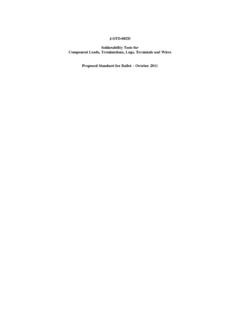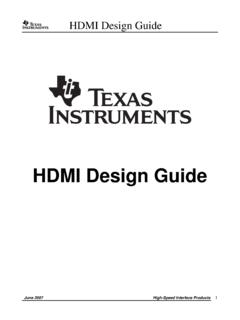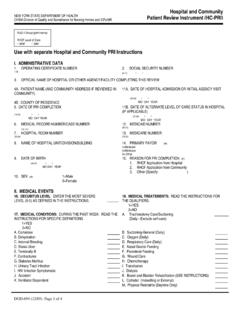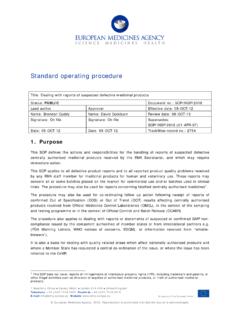Transcription of Design Guidelines for RCD Snubber of Flyback Converters
1 Application Note AN-4147 Design Guidelines for RCD Snubber of Flyback 2006 Fairchild Semiconductor AbstractThis article presents some Design Guidelines for the RCDsnubber of Flyback Converters . When the MOSFET turns off,a high-voltage spike occurs on the drain pin because of a res-onance between the leakage inductor (Llk) of the main trans-former and the output capacitor (COSS) of the MOSFET. Theexcessive voltage on the drain pin may lead to an avalanchebreakdown and eventually damage the MOSFET. Therefore,it is necessary to add an additional circuit to clamp the volt-age. IntroductionOne of the most simple topologies is a Flyback converter. Itis derived from a buck-boost converter by replacing filterinductors with coupled inductors, such as gapped core trans-formers. When the main switch turns on, the energy is storedin the transformer as a flux form and is transferred to outputduring the main switch off-time. Since the transformer needsto store energy during the main switch on-time, the coreshould be gapped.
2 Since Flyback Converters need very fewcomponents, it is a very popular topology for low- andmedium-power applications such as battery chargers, adapt-ers, and DVD players. Figure 1 shows a Flyback converter operating in continuousconduction mode (CCM) and discontinuous conductionmode (DCM) with several parasitic components, such as pri-mary and secondary leakage inductors, an output capacitorof MOSFET, and a junction capacitor of a secondary ++iDVon:1 LmimLlk2 CjCossVin+nVoiDidVdsresonance betweenLlk1 and Cossdiode reverserecovery currentVin+nVoiDidVdsresonance betweenLm and Cossresonance betweenLlk1 and CossididVinidiDidiDtttt(a) Configuration with parasitic components(b) CCM operation(c) DCM operationFigure 1. Flyback Converter; (a) Configuration with Parasitic Components, (b) CCM Operation, (c) DCM OperationAN-4147 APPLICATION NOTE 2006 Fairchild Semiconductor When the MOSFET turns off, the primary current (id)charges COSS of the MOSFET in a short time.
3 When thevoltage across COSS (Vds) exceeds the input voltage plusreflected output voltage (Vin+nVo), the secondary diodeturns on, so that the voltage across the magnetizing inductor(Lm) is clamped to nVo. There is, therefore, a resonancebetween Llk1 and COSS with high-frequency and high-volt-age surge. This excessive voltage on the MOSFET maycause failure. In the case of the CCM operation, the second-ary diode remains turned on until the MOSFET is gated the MOSFET turns on, a reverse recovery current ofthe secondary diode is added to the primary current, andthere is a large current surge on the primary current at theturn-on instance. Meanwhile, since the secondary currentruns dry before the end of one switching period in the case ofthe DCM operation, there is a resonance between Lm andCOSS of the MOSFET. Snubber designThe excessive voltage due to resonance between Llk1 andCOSS should be suppressed to an acceptable level by an addi-tional circuit to protect the main switch.
4 The RCD snubbercircuit and key waveforms are shown in Figures 2 and 3. TheRCD Snubber circuit absorbs the current in the leakageinductor by turning on the Snubber diode (Dsn) when Vdsexceeds Vin+nVo. It is assumed that the Snubber capacitanceis large enough that its voltage does not change during oneswitching period. When the MOSFET turns off and Vds is charged to Vin+nVo,the primary current flows to Csn through the Snubber diode(Dsn). The secondary diode turns on at the same time. There-fore, the voltage across Llk1 is Vsn-nVo. The slope of isn is asfollows: Figure 2. Flyback Converter with RCD Snubber Figure 3. Key Waveforms of the Flyback Converter with RCD Snubber in DCM Operationwhere isn is the current that flows into the Snubber circuit,Vsn is the voltage across the Snubber capacitor Csn, n is theturns ratio of the main transformer, and Llk1 is the leakageinductance of the main transformer. The time ts is obtainedby: where ipeak is the peak current of the primary current.
5 The Snubber capacitor voltage (Vsn) should be determined atthe minimum input voltage and full-load condition. Once Vsnis determined, the power dissipated in the Snubber circuit atthe minimum input voltage and full-load condition isobtained by: where fs is the switching frequency of the Flyback should be 2~ times of nVo. Very small Vsn results in asevere loss in the Snubber circuit, as shown in the aboveequation. (1)snsnolk 1diVnVdtL = VinVsnRsnDsnLlkidVds++Csnisn+iDVon:1ipea ktsVinVsnnVoiDidisnVds(2)lk 1speaksnoLtiVnV= (3)peaks2snsnsnslkpeakssnoitV1 PVf Lif22 VnV == AN-4147 APPLICATION NOTE 2006 Fairchild Semiconductor the other hand, since the power consumed in the snubberresistor (Rsn) is Vsn2/Rsn, the resistance is obtained by: The Snubber resistor with the proper rated power should bechosen based on the power loss. The maximum ripple of thesnubber capacitor voltage is obtained as follows: In general, 5~10% ripple is reasonable.
6 Therefore, the snub-ber capacitance is calculated using the above equation. When the converter is designed to operate in CCM, the peakdrain current, together with the Snubber capacitor voltage,decreases as the input voltage increases. The Snubber capaci-tor voltage under maximum input voltage and full-load con-dition is obtained as follows: where fs is the switching frequency of the Flyback converter,Llk1 is the primary-side leakage inductance, n is the turnsratio of the transformer, Rsn is the Snubber resistance, andIpeak2 is the primary peak current at the maximum input volt-age and full-load condition. When the converter operates inCCM at the maximum input voltage and full-load condition,the Ipeak2 is obtained as follows: When the converter operates in DCM at the maximum inputvoltage and full-load condition, the Ipeak2 is obtained by: where Pin is the input power, Lm is the magnetizing induc-tance of the transformer, and VDCmax is the rectified maxi-mum input voltage in DC value.
7 Verify that the maximum value of Vds is below 90% and80% of the rated voltage of the MOSFET (BVdss), at thetransient period and steady-state period, respectively. Thevoltage rating of the Snubber diode should be higher thanBVdss. Usually an ultra-fast diode with 1A current rating isused for the Snubber circuit. ExampleAn adapter using FSDM311 has following specifications:85 Vac to 265 Vac input voltage range, 10W output power, 5 Voutput voltage, and 67kHz switching frequency. When theRCD Snubber uses a 1nF Snubber capacitor and 480k snub-ber resistor, Figure 4 shows several waveforms with 265 Vacat the instance of the AC switch turn-on. Figure 4. Start-up Waveforms with 1nF Snubber Capacitor and 480k Snubber Resistor In Figures 4-7, Channel 1 through 4 stand for the drain volt-age (Vds, 200V/div), the supply voltage (VCC, 5V/div), thefeedback voltage (Vfb, 1V/div), and the drain current (Id, ), respectively.
8 The maximum voltage stress on theinternal SenseFET is around 675V, as shown in Figure voltage rating of FSDM311 is 650V, according to thedatasheet. There are two reasons for the excess of the voltageratings: the wrong transformer Design and/or the wrongsnubber Design . Figure 5 shows the reason. Figure 5. Steady-State Waveforms with 1nF SnubberCapacitor and 480k Snubber Resistor(4)2snsn2snlk 1 peakssnoVRV1 Lif2 VnV= (5)snsnsnsnsVVCR f =(6)22oosnlk1speak2sn 2nV( nV )2R Lf ( I)V2++=(7)maxmaxinDCoDCopeak 2maxmaxDCo msDC oP(VnV )VnVIVnV2Lf(V nV)+ =+ +(8)inpeak 2sm2 PIf L=574V451 VAN-4147 APPLICATION NOTE 2006 Fairchild Semiconductor the reliability, the maximum voltage stress at the steadystate should be equal to 80% of the rated voltage (650V * 520V). Figure 5 shows the voltage stress on the internalSenseFET is above 570V with Vin = 265 Vac at steady , the fact that Vin+nVo is around 450V (= 375V +15 * 5V) implies the turns ratio of the transformer is 15,which is a reasonable value.
9 Therefore, the Snubber circuitshould be redesigned. Let Vsn be twice that of nVo, 150V, and Llk1 and ipeak is 150 H and 400mA by measuring, respectively. Obtain thesnubber resistance as follows:The power emission from Rsn is calculated as follows:Let the maximum ripple of the Snubber capacitor voltage be10% and the Snubber capacitance is obtained as follows:The results with 14k (3W) and 10nF are shown in Figures6 and 7. Figure 6. Start-up Waveforms with 10nF Snubber Capacitor and 14k Snubber Resistor Figure 7. Steady-State Waveforms with 10nF Snubber Capacitor and 14k Snubber ResistorThe voltage stresses on the internal SenseFET are 593V and524V at the startup and steady state, respectively. These arearound and of the rated voltage of FSDM311,respectively. (9)2snsn2snlk 1 k2150 75 = == (10) =(11)snsnsn sn sV150C10nFVR f 1514k 67k == = DISCLAIMER FAIRCHILD SEMICONDUCTOR RESERVES THE RIGHT TO MAKE CHANGES WITHOUT FURTHER NOTICE TO ANY PRODUCTS HEREIN TO IMPROVE RELIABILITY, FUNCTION, OR Design .
10 FAIRCHILD DOES NOT ASSUME ANY LIABILITY ARISING OUT OF THE APPLICATION OR USE OF ANY PRODUCT OR CIRCUIT DESCRIBED HEREIN; NEITHER DOES IT CONVEY ANY LICENSE UNDER ITS PATENT RIGHTS, NOR THE RIGHTS OF SUPPORT POLICY FAIRCHILD S PRODUCTS ARE NOT AUTHORIZED FOR USE AS CRITICAL COMPONENTS IN LIFE SUPPORT DEVICES OR SYSTEMS WITHOUT THE EXPRESS WRITTEN APPROVAL OF THE PRESIDENT OF FAIRCHILD SEMICONDUCTOR CORPORATION. As used support devices or systems are devices or systems which, (a) are intended for surgical implant into the body, or (b) support or sustain life, or (c) whose failure to perform when properly used in accordance with instructions for use provided in the labeling, can be reasonably expected to result in significant injury to the critical component is any component of a life support device or system whose failure to perform can be reasonably expected to cause the failure of the life support device or system, or to affect its safety or NOTE 2006 Fairchild Semiconductor by Gwan-Bon Koo/ Ph.














